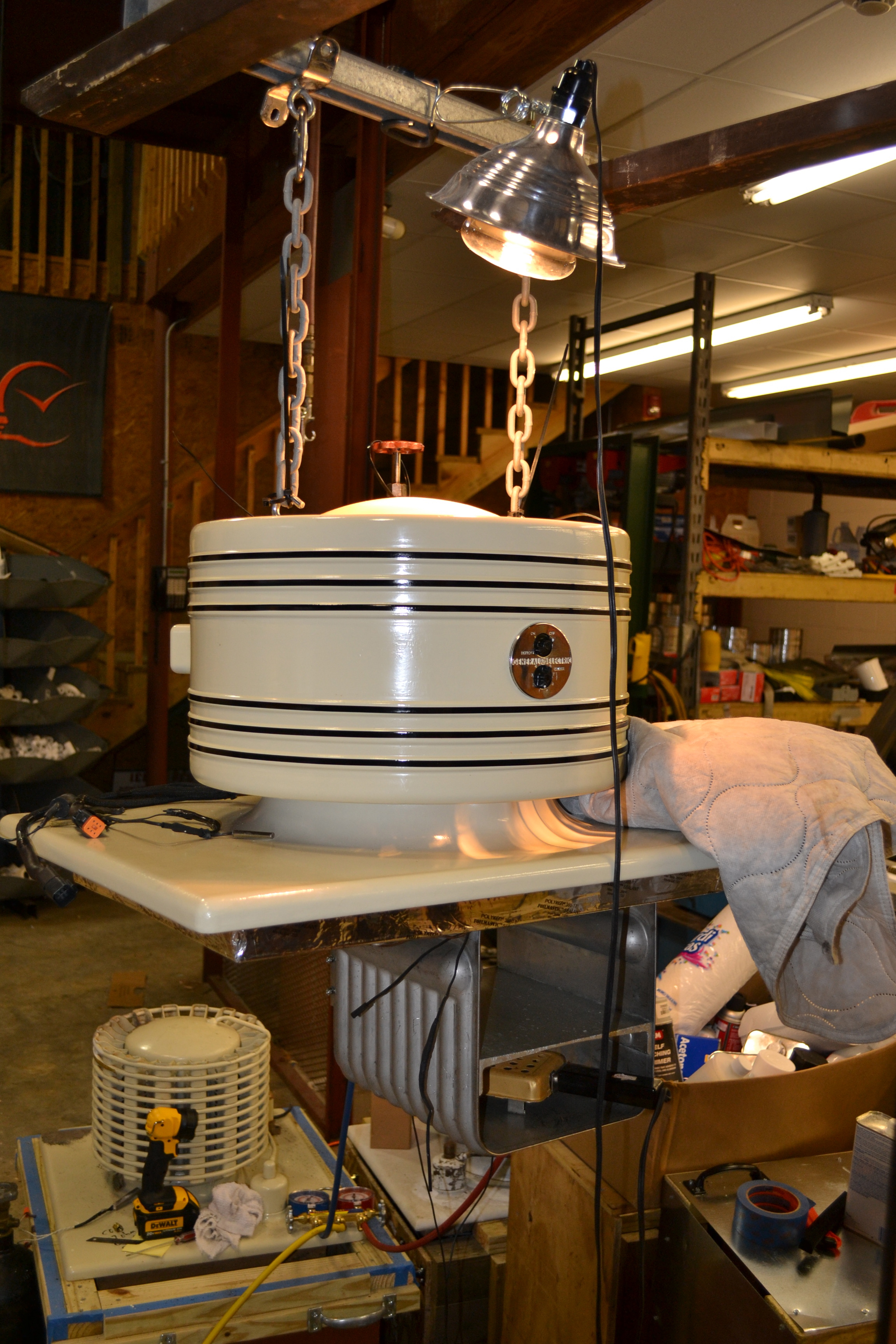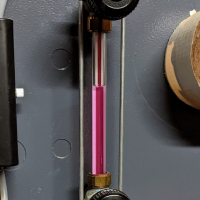Can't get minisplit outdoor unit to stay at 500 microns
No biggie, to play it safe and do it right I'll just recover the 2.5lb charge and install virgin 410.
After the recovery, I pulled two vacuums with an N2 purge in between. I can easily reach 500 microns on the line set in < 2mins with the service valves closed. Once I open the valves, I can get to 500 again in about 10-15 mins and go down to 400 but...my gauge marches micron by micron up to 800 after 5 mins. If I repeatedly bring it back down to 400, that micron march slows to about <0.1 micron a second which is ~ 5-6 microns/minute.
I've repeated that process many times to get to that point.
The question:
What is it that is incrementally adding these microns?
Do I need to flush the system with a anti-micronial solution?
Comments
-
-
Yes you will Always add much more time to your evacuation time when your sucking on the compressor.
Gary0 -
What are the chances of adversely affecting the oil from a lot of time under a vacuum? At what point does it or parts of it boil off?0
-
You won't hurt the oil by pulling a tight vacuum. If anything, it helps it since it's causing the refrigerant to boil out of it.
Cool oil causes refrigerant to condense in it. Once that happens, it can take quite a bit of heat and vacuum to boiler it out and draw it off.
You probably don't need to do it any more, but if you must, take Harvey's advice and heat up the crankcase til it's well over 120* while evacuating and keep it that hot until your micron gauge stops rising.Bob Boan
You can choose to do what you want, but you cannot choose the consequences.0 -
I'm not as worried about the small amount of refrigerant in the oil as I am about moisture.0
-
Should I assume that where there is refrigerant there could be moisture and therefore put the effort into retrieving that last little bit?
Or is it a just splitting hairs?0 -
I once had a similar problem and after a long day I discovered that the mini split adapter valve was not good due to being over tightened....0
-
-
You know this is really bothering me.Ironman said:You won't hurt the oil by pulling a tight vacuum. If anything, it helps it since it's causing the refrigerant to boil out of it.
Cool oil causes refrigerant to condense in it. Once that happens, it can take quite a bit of heat and vacuum to boiler it out and draw it off.
You probably don't need to do it any more, but if you must, take Harvey's advice and heat up the crankcase til it's well over 120* while evacuating and keep it that hot until your micron gauge stops rising.
Back in 2013 JB's FAQ said going below 300 microns or so would degas the compressor oil.
I just checked before responding and now it says to pull to at least 250 microns for 5 minutes and lower if using polyester oil?
What gives? I could've pulled my monitor top much lower but stopped because I didn't want to risk damaging the 80 year old oil.
Hell, I could've easily got the thing down below 50 microns!
Single pipe quasi-vapor system. Typical operating pressure 0.14 - 0.43 oz. EcoSteam ES-20 Advanced Control for Residential Steam boilers. Rectorseal Steamaster water treatment0 -
Hi ChrisJ. IT MAKES ME HAPPY THAT YOU ARE BOTHERED!!!!!!!!LOLOLOLOLOLOLOL!AND ON AND ON.0
-
Thanks pal.Techman said:Hi ChrisJ. IT MAKES ME HAPPY THAT YOU ARE BOTHERED!!!!!!!!LOLOLOLOLOLOLOL!AND ON AND ON.
 Single pipe quasi-vapor system. Typical operating pressure 0.14 - 0.43 oz. EcoSteam ES-20 Advanced Control for Residential Steam boilers. Rectorseal Steamaster water treatment0
Single pipe quasi-vapor system. Typical operating pressure 0.14 - 0.43 oz. EcoSteam ES-20 Advanced Control for Residential Steam boilers. Rectorseal Steamaster water treatment0 -
Tell me one more time, why can you not have a SGMI in a mini split?At my very 1st mini class I asked and the "INSTRUCTOR" said "THERE WAS A PULSE WAVE THAT WENT THRU THE COPPER TUBING TO CHECK FOR ABNORMALITIES". say what???????????. I've done it, will still do it.
Now in the real world, the SGMI is KindaSorta "dry" below 75-85 ppm.That 50microns is lower than the SGMI ppm by a few. You did more than most so called mechanics say they do .0 -
ChrisJ said:
Yeah, I read the JB "Principals of Vacuum" .pdf and that's what caused me concern.Ironman said:
Back in 2013 JB's FAQ said going below 300 microns or so would degas the compressor oil.
I just checked before responding and now it says to pull to at least 250 microns for 5 minutes and lower if using polyester oil?
I just wrote to JB asking them to clarify what is stated in the .pdf vs. what is stated in Pump FAQ #15.0 -
I believe there are some systems that just won't get to where we would like them to be, especially with the new factory-installed sponge (POE oil) we all see. If you evacuate to 350 microns, for example, and you have done all the right things (removed valve cores, changed pump oil, etc.) and the system rises to 750, and it does that 5 times in a row, I believe you have done all that is possible with that particular system.
In light of that, I certainly would do annual drier PD and refrigerant static checks; if nothing else but to make you feel better.0 -
Not yet and thanks for the reminder.
I filled out their online form so therefore I'll have to recall what I wrote. I'll try again now.0 -
Don't know where you are located but evacuating in cold temps. is tough. Usually when you shut the pump off and the vac rises and then stops it means you have moisture. Heat applied to warm the system will help as Harvey mentioned. Also make sure to check your hoses and fittings as others have mentioned you could be leaking there.
Also, you should use new vac pump oil.0 -
The vacuum oil is certainly always fresh and its just one hose between the pump and the core tool.
The temps have been in the 40s during the day.
Still waiting on JB's response. I sent an e-mail directly to engineering.0 -
This may be a dumb question but I assume you used copper tubing and not rubber hoses to connect?
I've had trouble with rubber hoses, no matter how new slowly leaking.Single pipe quasi-vapor system. Typical operating pressure 0.14 - 0.43 oz. EcoSteam ES-20 Advanced Control for Residential Steam boilers. Rectorseal Steamaster water treatment0 -
I use the 3/8 hose from my manifold set but that's irrelevant.
The system is isolated from the pump at the core removal tool.
I'm using an Appion CRT with a BluVac mounted to it and they are right at the service port.
The hose is on the other side of the valve and the BluVac. The BluVac isn't reading the hose at all.
The only possible outside influence would be the core tool but the micron marching only happens when the service valves are open and the outdoor unit is part of the test.
With the service valves closed and only the line set and indoor unit as part of the test, the micron level is rock steady.
0 -
Sadly, this is way above my head.
I've only used my YellowJacket 69086 but to me, it sounds like either the unit has a leak, or a ton of moisture in the oil.
I know some of the guys on our fridge forum that restore monitor tops often leave the pump running all night with high wattage lamps shining on the compressor and condenser to keep them hot.
That always suggested to me that it can take an excessively long time to remove all of the moisture. But like I said, I'm fairly new to all of this.

Did you try charging the unit and then using a gas sniffer to find a possible leak?Single pipe quasi-vapor system. Typical operating pressure 0.14 - 0.43 oz. EcoSteam ES-20 Advanced Control for Residential Steam boilers. Rectorseal Steamaster water treatment0 -
Well 40 deg makes it tough. Water vaporizes at 6000 microns at 40. The compressor could be colder than that from sitting overnight. Warm it up, sweep with nitrogen, put oversized drier in evacuate and let it rip0
-
I guess a leak is possible. There's no sign of shipping or handling damage.
The unit is new and some air may have gotten into the system during the install between the final vac and the charging.
Just a fumbling of the ball at the darkening end of a cold day on a roof.0 -
Next time up on the roof I'll bring a small 1500W space heater.
Gotta get these taxes done first. Its late March.0 -
Could be your best bet.Stenty said:Next time up on the roof I'll bring a small 1500W space heater.
Gotta get these taxes done first. Its late March.
And perhaps, keep the pump running all night long like this guy does constantly. He throws heat on it and runs the pump. The big difference is you at least have a drier, these units do not.
I chickened out and only pulled my first one down to 450 microns. Perhaps I'll go much lower next time as I still haven't found anything saying it's bad besides that one thing from JB. Single pipe quasi-vapor system. Typical operating pressure 0.14 - 0.43 oz. EcoSteam ES-20 Advanced Control for Residential Steam boilers. Rectorseal Steamaster water treatment0
Single pipe quasi-vapor system. Typical operating pressure 0.14 - 0.43 oz. EcoSteam ES-20 Advanced Control for Residential Steam boilers. Rectorseal Steamaster water treatment0 -
Still no reply to either of my two e-mails to JB Industries.0
-
Just so there is more to worry about....over the years while running a vac pump on systems, the vac pump stopped because either it got unplugged or was simply shut off with out being valved off at the manifold. Each time the vacuum in the system drew the oil out of the pump into the hoses heading into the system (although it never made that far.) I learned to avoid this as it created quite a mess. Back then with units charged with mineral oil this would not have been a real serious issue, just redo the evacuation process and be sure to put on a new liquid line filter.
I always valve off the 3/8" hose and break the vacuum in the hose before switching off the pump.
But today with 410A/oil I never leave the pump out of earshot.
I have enquired about some method of check valve for the pump or hoses and drew blank stares. Do any new vac pumps make provisions to prevent this?? in case of power or pump failure?
0 -
I just accidently stumbled across a U tube by LG. Made by the manf across the pond to the west. They mention a "one way valve" for this very reason. Does anyone know of a source for this check valve? I inquired at 2 of the largest HVAC wholesale suppliers in the Midwest and they could not come up with anything.0
-
How about this:
http://www.mcmaster.com/#air-check-valves/=whfhb40 -
I had considered a check valve but was concerned about pressure drop/loss across the valve and also more fittings to lose vacuum thru.
I don't have to pump down a system very often. When I do there are usually other tasks close at hand to do, (elec-t-stat-etc)
and I can hear the pump run in the basement thru ACR lines.
Thanks for the info though!
.
0 -
Can you use the same oil as used in the system so if it happens it won't matter?JUGHNE said:I had considered a check valve but was concerned about pressure drop/loss across the valve and also more fittings to lose vacuum thru.
I don't have to pump down a system very often. When I do there are usually other tasks close at hand to do, (elec-t-stat-etc)
and I can hear the pump run in the basement thru ACR lines.
Thanks for the info though!
.Single pipe quasi-vapor system. Typical operating pressure 0.14 - 0.43 oz. EcoSteam ES-20 Advanced Control for Residential Steam boilers. Rectorseal Steamaster water treatment0 -
No, I don't believe so. 410A oil absorbs moisture from the air. If you have ever had your vacuum pump tip over on its side (and you are greeted with a mess in your truck
 ) you know the oil is exposed to the air all the time.
) you know the oil is exposed to the air all the time.
I believe the lubrication of the pump would suffer with oil saturated with moisture. Which is why you can't change the pump oil too often.0 -
This is also what the ballast valve helps with as well, correct? Venting excess moisture before you get down to a deep vacuum?JUGHNE said:No, I don't believe so. 410A oil absorbs moisture from the air. If you have ever had your vacuum pump tip over on its side (and you are greeted with a mess in your truck
 ) you know the oil is exposed to the air all the time.
) you know the oil is exposed to the air all the time.
I believe the lubrication of the pump would suffer with oil saturated with moisture. Which is why you can't change the pump oil too often.
When pulling methyl formate I left that cracked the entire time. Was quite nervous as well, 1: it's flammable and 2: I was told it melts plastic. So far, no damage to my pump so i guess I kept it in a vapor state and kept it diluted enough.
Problem is, it's a liquid up to 89F at atmosphere so I needed to remove it some how. I did change my oil twice during it as well.
Single pipe quasi-vapor system. Typical operating pressure 0.14 - 0.43 oz. EcoSteam ES-20 Advanced Control for Residential Steam boilers. Rectorseal Steamaster water treatment0 -
Well I had to find and read the book for my Robinair 15101-A; (1984 model by the way....you see I don't do a lot of systems).
The ballast valve adds air to the exhaust chamber to prevent condensation of whatever you removing. This prevents the oil in the pump from becoming contaminated so quickly.
410a oil has been described as a "sponge " for water absorption and this changed the game of ACR charging considerably from 20 years ago or so.
If you purge/flush your system several times with dry nitrogen then there would be less residue left for the vacuum pump to deal with.0 -
In between the micron gauge connection and the system there has to be a gasket or "o" ring or something, how is that thing? On my JB micron digital meter there is a little "o" ring that I change a couple of times a year, when it gets goushed too many times.0
Categories
- All Categories
- 85.7K THE MAIN WALL
- 3K A-C, Heat Pumps & Refrigeration
- 49 Biomass
- 418 Carbon Monoxide Awareness
- 72 Chimneys & Flues
- 1.9K Domestic Hot Water
- 5.2K Gas Heating
- 92 Geothermal
- 160 Indoor-Air Quality
- 3.2K Oil Heating
- 59 Pipe Deterioration
- 848 Plumbing
- 5.8K Radiant Heating
- 371 Solar
- 14.5K Strictly Steam
- 3.2K Thermostats and Controls
- 50 Water Quality
- 38 Industry Classes
- 47 Job Opportunities
- 15 Recall Announcements





